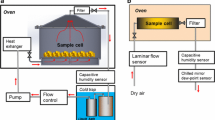Abstract
This study presents a numerical simulation of the performance of an NMR spectrometer in which the influence of equipment with both low and high spatial resolutions is investigated. The results indicate that a low resolution NMR with a wide sensitivity curve may be unable to provide an accurate estimation of the moisture profile along the whole length of a test sample where the moisture gradient changes abruptly. It cannot provide accurate moisture information over a distance measured from each end of the test sample equivalent to the effective width of the sensitivity curve. However, a low-resolution spectrometer does not show any significant errors when calculating liquid diffusion coefficients, although the range of moisture contents over which they can be measured is limited. This study suggests that to avoid errors and practical difficulties, NMR spectrometers for moisture measurement should be selected carefully by matching the effective width of the sensitivity curve to the moisture properties of the material to be measured.
Résumé
Cette étude présente une simulation numérique de l'exécution d'un spectromètre RMN étudiant l'influence d'un matériel à basses et hautes résolutions spatiales. Les résultats indiquent qu'il se peut qu'une basse résolution du RMN avec une courbe large de sensibilité ne soit pas en mesure de fjurnir une évaluation précise du profil d'humidité sur la longueur entière d'un échantillon d'essai où le gradient d'humidité change soudainement. Il ne peut pas fournir d'informations précises sur l'humidité au-dessus d'une distance mesurée à partir de chaque extrémité de l'échantillon d'essai équivalant à la largeur effective de la courbe de sensibilité. Cependant, un spectromètre à basse résolution ne montre aucune erreur significative lors du calcul des coefficients de diffusion liquide, bien que l'intervalle du contenu d'humidité au-dessus duquel elles peuvent être mesurées soit limité. Cette étude suggère que pour éviter des erreurs et des difficulté pratiques, les spectromètres RMN mesurant l'humidité soient choisis soigneusement en associat la largeur effective de la courbe de sensibilité aux propriétés d'humidité du matériel à mesurer.
Similar content being viewed by others
References
Hagentoft, C. E., ‘The impact of heat, air and moisture transport on energy demand and durability’, IEA Annex 24 Report 5: Performances and Practice, K-U Leuven 1998, 35–49.
Krus, M., ‘Moisture transport and storage coefficients of porous mineral building materials, theoretical principles and new test methods, Fraunhofer IRB Verlag, 1996.
Brocken, H. J. P., ‘Moisture transport in brick masonary: The gray area between bricks’, PhD Thesis. Eindhoven University of Technology, The Netherlands, 1998.
Pel, L., ‘Moisture transport in porous building materials’, PhD Thesis, Eindhoven University of Technology, The Netherlands, 1995.
Pel, L., Kopinga, K. and Brocken, H., ‘Moisture transport in porous building materials’,HERON 41 (1996) 95–105.
Justnes, H., Bryhn-Ingebrigsten, K. and Rosvold, G. O., ‘Neutron radiography: an excellent method of measuring water penetration and moisture distribution in cementitious materials’,Advances in Cement Research 6 (1994) 67–72.
Kumaran, M. K. and Bomberg, M., ‘A Gamma-Spectrometer for determination of density distribution and moisture distribution in building materials’, Proceedings of the International Symposium on Moisture and Humidity, Washington D.C. (1985), S 485-490.
Adan, O. C. G., ‘Determination of moisture diffusivities in gypsum renders’,HEROn 40 (3) (1995) 201–216.
Munsi, A.Y., Galbraith, G. H., Sanders, C. H. and McLean, R. C., ‘Problems of moisture measurement with low resolution NMR’, Proceedings of CIB W 40 Meeting, Czech Technical University, Faculty of Civil Engineering, Prague, August 30–September 3, 1999, 129–134.
Kumaran, M. K., ‘Report on analytical methods to derive moisture diffusivity from transient moisture distribution’, Prepared for IEA Annex XXIV, Institute for Research in Construction, National Research Council Canada, T3-CA-92/04.
Dow, G. T. and Alston, M., ‘Preliminary measurements of moisture in building materials using NMR spectroscopy’, CIB W40: Kyoto 1997, 107–112
Garvin, S. L., Phillipson, M. C., Sanders, C. H., Hayles, C. S. and Dow, G. T., ‘Impact of climate change on building’, BRE Report 349, BRE, UK, 1998.
Author information
Authors and Affiliations
Rights and permissions
About this article
Cite this article
Galbraith, G.H., Guo, J., McLean, R.C. et al. The effect of instrument resolution on diffusion coefficients measured using NMR spectroscopy. Mat. Struct. 34, 389–395 (2001). https://doi.org/10.1007/BF02482284
Received:
Accepted:
Issue Date:
DOI: https://doi.org/10.1007/BF02482284




